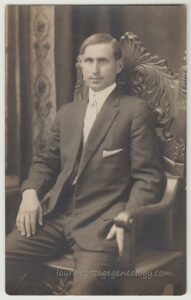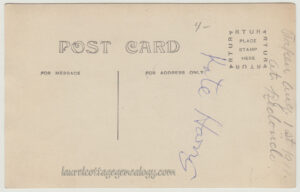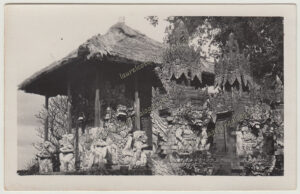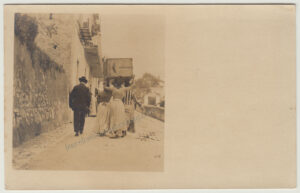

Real Photo Postcard, circa 1907 – 1918. Detroit, Michigan. AZO Stamp Box.
Price: $10.00
We’re taking liberties with the title of this post by presuming that the subject above lived in Detroit. In any case, he’s a handsome guy, here in dark suit, light-colored tie and pocket handkerchief, and a detachable collar. He’s seated in a carved wooden chair, which most likely, belonged to the photographer. And we wonder if this chair could have folded – is that a seam we’re seeing on our right above the armrest, or is it just part of the carving?
The time-frame for the card is based on the AZO stamp box, all four triangles pointing up, and the fact that it is a Divided Back card.
As for the photographer: Charles John Merz, son of Christian Merz and Elizabeth Trost, was born September 14, 1872, in Michigan. Both parents were born in Germany. He married Buffalo, New York native,Tillie Bischy on June 5, 1901. Their daughter, Olive, was born about 1905. And, it turns out that Merz was in the photography business for decades, which is unusual for the time, given that most photographers (and there was so many that went into the trade) had either a rather short-lived career, or had moved on to other occupations by the 1920s. (It would be interesting to see statistics on this subject.)
Charles appears to have gotten started in the photography business around age 20, or a little earlier. The 1893 city directory shows he was working for, or with, photographer, Herman Baron, at 49 Monroe Ave in Detroit. By 1896 he is with the C. M. Hayes & Co. studio, and listed as a printer. The most recent city directory with the Michigan Avenue business address was found for 1919. On the 1920, ’30 and ’40 census records he is listed as a commercial photographer. By 1930 he, Tillie and Olive, are living in Livonia.
In searching for other photographs or cards several can be currently found for sale online. But, the Clements Library at the University of Michigan holds an old album containing photos from 1888 to about 1910, about 147 total, including a self-portrait. These images are not online but see the link below for more info.
Sources: “Real Photo Postcard Stamp Boxes A-B.” (Playle.com). https://www.playle.com/realphoto/photoa.php. (accessed May 24, 2022).
Year: 1880; Census Place: Frenchtown, Monroe, Michigan; Roll: 595; Page: 399B; Enumeration District: 178. (Ancestry.com).
R. L. Polk & Co.’s Detroit City Directory, 1893. pp. 232 and 847. Ancestry.com. U.S., City Directories, 1822-1995.
R. L. Polk & Co.’s Detroit City Directory, 1895. p. 961. Ancestry.com. U.S., City Directories, 1822-1995.
Year: 1900; Census Place: Detroit Ward 10, Wayne, Michigan; Roll: 751; Page: 3; Enumeration District: 0109; FHL microfilm: 1240751. (Ancestry.com).
Michigan Department of Community Health, Division of Vital Records and Health Statistics; Lansing, MI, USA; Michigan, Marriage Records, 1867-1952; Film: 73; Film Description: 1901 Tuscola-1902 Branch. (Ancestry.com).
Year: 1910; Census Place: Detroit Ward 14, Wayne, Michigan; Roll: T624_686; Page: 13B; Enumeration District: 0217; FHL microfilm: 1374699. (Ancestry.com).
Ancestry.com. U.S., World War I Draft Registration Cards, 1917-1918.
R. L. Polk & Co.’s Detroit City Directory, 1919. p. 2840. Ancestry.com. U.S., City Directories, 1822-1995.
Year: 1920; Census Place: Detroit Ward 15, Wayne, Michigan; Roll: T625_814; Page: 4A; Enumeration District: 457. (Ancestry.com).
Year: 1930; Census Place: Livonia, Wayne, Michigan; Page: 5A; Enumeration District: 1015; FHL microfilm: 2340810. (Ancestry.com).
Year: 1940; Census Place: Livonia, Wayne, Michigan; Roll: m-t0627-01833; Page: 12A; Enumeration District: 82-177A. (Ancestry.com).
“Charles J. Merz Photograph Album (1888 – ca. 1910).” Charles J. Merz photograph album, William L. Clements Library, The University of Michigan. (accessed May 24, 2022).


























